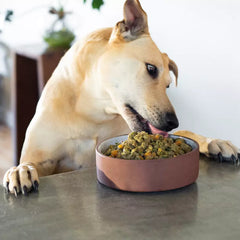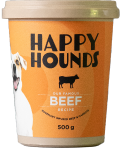Shop

How Much Should You Feed Your Dog? Your Ultimate Feeding Guide!
July 31, 2024 4 min read
The most important thing when feeding your dog is ensuring they receive the proper balance of nutrients for their development and overall health. Your dog’s diet will impact their physical condition (like weight and muscle tone), their skin, teeth, coat and digestive health, as well as their immune system which is important for fighting off any potential illness or infection. That’s why at Happy Hounds, we’ve developed meals that are complete and balanced for puppies and adults, with a variety of protein sources and fresh vegetables, herbs and fruit. This means your dog will be getting the right mix of protein, carbohydrates, fats and oils, amino acids, vitamins and minerals needed to be their healthiest and happiest self.
How much should I feed my puppy?
Pups have a lot of rapid growing to do so they need a lot more calories and protein. Their required protein intake is highest right after weaning and will decrease as they grow. They need healthy amounts of fats, calcium and carbohydrates too.
The Happy Hounds Feeding Guide will help you calculate the requirements of your growing puppy to ensure they’re getting what they need! We use their ideal mature weight (rather than their weight as a puppy) to calculate how much they should be eating as they grow. Puppies with an expected adult weight less than 30kgs can switch to the adult food guide once they are around 12 months old. Puppies with an expected weight over 30kgs can switch at around 16 months old.
How many times a day should my puppy eat?
Puppies can be fed throughout the day with measured portions to sustain their healthy development. Younger puppies can be fed three times a day and reduced to twice daily after they are around 6 months old. Consistent meal times will help build a routine (for eating and going potty) and reduce chances of overeating which can be the case when puppies are left to free-feed.
How much food should I feed my dog?
Like people, eating requirements will differ from dog to dog. They too can experience weight problems and their nutritional requirements can fluctuate with age and varied activity levels. There is no one-size-fits-all answer but we can guide you in assessing your dog’s food requirements!
Generally your dog’s ideal weight is a good indicator of how much food they need. Large dog breeds will obviously need more than a dachshund’s serving of food. The standard recommendation for daily food requirements in grams is based on your dog’s weight in kilograms. You’ll need to adjust these portion recommendations if your dog is over- or underweight. Further adjustments might need to be made based on the following factors…
Activity levels. Your dog’s lifestyle will affect the amount of calories they need to get through the day. A snuggly couch potato will not need to eat as much as a ball-chasing firecracker. We need to ensure their calorie intake is providing them with enough sustenance for energy and muscle maintenance, without being more than what they need.
Age. We’ve mentioned how puppies need more nutrients and calories to support their growth and development. Aging dogs can eat less as they become less active and their metabolism slows down in their retirement era.
How many times a day should a dog eat?
Your dog should be getting at least two meals a day. If your schedule allows you to feed them three times, you can, but this isn’t realistic for many families. Having consistent meal times and creating a set routine is beneficial for your dog, so feeding times that fit into your schedule are a good idea. Try to keep meals less than 12 hours apart because, like us, dogs can experience nausea on empty tummies.

Regular meal times should go hand-in-hand with consistent portion sizes. It’s up to us as dog owners to be mindful of portion control and avoid over- or underfeeding. A common miscalculation we see is paw-parents underestimating the significance of treats. Treats are an essential training tool and also a love-language for many pet owners, but they are still food and can lead to overfeeding. It’s not always easy to limit treats, especially when training, so remember to adjust portion sizes if your doggo has had a treat-heavy day. We also recommend using treats that are nutritious so if you are reducing the size of your dog’s meal, they are still getting the nourishment they need.

How much to feed my dog by weight (kg)
We can’t safely give you a definitive answer because all dog foods are formulated differently. The amount of food your dog needs would vary based on the nutritional value that different brands offer. The amount would also change from dog to dog because of the factors we’ve mentioned, like ideal weight, activity levels and age.
Don’t worry though, we’ve created a Happy Hounds Feeding Guide to help you find that sweet spot for your dog. The guide incorporates activity levels to determine ideal feeding amounts - whether for a couch potato or a very active ball-chaser. Our fresh food takes the guesswork out of nutrition, where more processed foods, like pellets, can be difficult to properly gauge portion sizes and manage nutrition when being poured straight from the bag.

Cost comparison
In addition to finding the right balance of nutrition, we know a big factor for pet owners is cost. We’ve kept this in mind when fine-tuning our Happy Hounds meals, and have created a cost comparison table to highlight value for pet parents. Our meals are packed with nutrients to make every bite count, using less and making sure your dog is satisfied. Take a look at our cost comparison
Now that you know how much to feed your dog and how Happy Hounds can make mealtimes easy and nutritious, you can focus on other important things, like scritches and fetch! Remember, our feeding guide is just that - a guide. Always monitor your dog and adjust their food as needed.











